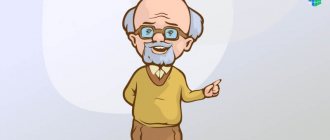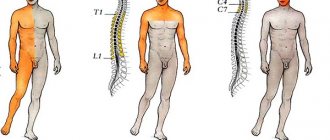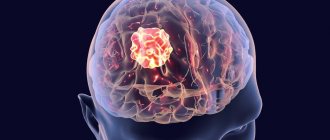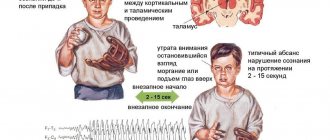What is the difference between hemiplegia and hemiparesis?
When one side of a child's body - left or right - becomes paralyzed, turns blue and swells, hemiplegia is diagnosed. In severe cases, in children it can even paralyze the muscles of the face and tongue. Left-sided or right-sided hemiplegia are distinguished. It often results from a stroke or birth injury, various lesions of the spinal cord and brain, circulatory disorders, tumors and infections of the brain.
When muscle strength decreases significantly in one half of the body and pain occurs, hemiparesis is diagnosed. It indicates damage to neurons in the brain or spinal cord; many children are often born with this pathology.
Spastic hemiplegia in children is often observed with cerebral palsy, which combines paralysis, muscle strain and various pathological reflexes. Only well-chosen physical exercises and massage can alleviate such a painful and uncomfortable condition.
About the disease
Right-sided hemiparesis is a pathology that is a right-sided lesion of the muscles of the body.
It is characterized by a noticeable decrease in strength and general motor ability of muscles, and incomplete paralysis of the limbs is possible.
This condition manifests itself due to acquired or congenital pathological changes in the pyramidal tracts and the brain.
Doctors observe deviations from the norm when a lesion appears in the left hemisphere of the brain.
This disease leads to the following consequences for the patient:
- Mobility and the patient’s ability to move independently, as well as to care for themselves independently, are reduced when hemiparesis occurs on the dominant side (right-sided hemiparesis in right-handed people);
- The patient experiences inflammatory changes that are associated with prolonged skeletal muscle cramps . This consequence occurs after serious disorders - intracerebral hemorrhages and strokes;
- A problem arises when trying to follow instructions for physical therapy when the patient is undergoing motor recovery due to limited mobility. This happens when there is spastic increased muscle tone.
In children
In children, this pathology occurs as a congenital disease . The reasons for its occurrence are abnormal functionality and structure of the brain , as well as birth injuries. In medical terminology, this disorder is called cerebral palsy - cerebral palsy.
Cerebral palsy appears due to a circulatory disorder in the brain. This pathology affects the fetus while still in the womb and leads to erroneous development and damage to brain structures.
Right spastic hemiparesis
Spastic hemiparesis, often called central, occurs when there is inflammation of the brain or cervical spinal cord.
With this disease, stiffness and muscle tension are observed in the limbs of the opposite side of the body. If individual nerves of the spinal cord are subject to inflammation, then hemiparesis is combined with weakness and decreased muscle tone.
This pathology does not immediately become noticeable; it manifests itself over several months. First, muscle tone increases, which creates tension in the arm and leg, a feeling of stiffness arises, and the ability of the limbs to move decreases. Then, if no treatment is followed, muscle tone continues to increase.
Important! An increase in muscle tone indicates damage to parts of the central nervous system - the brain and spinal cord.
Disturbances in movements that are accompanied by spasticity are seen by others from the outside based on distinctive signs - people have difficulties in gait, it acquires special features. Doctors call it Wernicke-Mann gait . This indicates diseases suffered by the brain - stroke and traumatic brain injury.
Symptoms of right-sided spastic hemiparesis are varied. These include speech disorders, fever, cognitive impairment and seizures similar to epileptic seizures.
Increased muscle tone indicates that the brain and spinal cord are damaged. To reduce tone, the doctor prescribes drugs that relax the muscles. The period of admission is usually long - up to six months, but sometimes longer.
Forecasts
So far, no supermethods or specialists have cured a single child from cerebral palsy with deep damage and, as a consequence, central spasticity. The diagnosis can be removed, but if the child had a mild degree of brain damage, in which many functions are preserved. If we are talking about deep and extensive damage to the brain tissue, then nothing can be done to force the brain to restore dead cells again, too many of them die, the structure is complex, and besides, the body quickly replaces the dead areas with connective tissue. Therefore, everything that can be restored bypassing the lost areas in childhood will be the result of treatment for hemiparesis. But with this form, one half of the body is working and this means a lot for the future formation of skills.
Disease by severity
Doctors determine the severity of various types of paresis on a six-point scale:
- 0 points – complete absence of movement;
- 1 point – minor muscle movements are observed, the joints are not involved;
- 2 points – movement is possible, but in a vertical position, if there is no external resistance. The joints move barely noticeably;
- 3 points – muscles cope with gravity. Joint movements are constrained;
- 4 points – the patient makes movements, while losing a little strength in the muscles;
- 5 points – the patient makes movements without losing muscle strength.
How to select specialists for the rehabilitation of a child with hemiparesis?
Usually the parents of such children are ready to do anything and believe everything in order to restore their children’s health. Unfortunately, there are unscrupulous people who try to sell useless services to parents who find themselves in difficult life situations. We have accumulated some experience in interacting with such children and their parents. Based on this, we would like to give advice to parents: for medical rehabilitation, select specialists with medical education, massage therapists, exercise therapy instructors, etc. From time to time it is advisable to undergo complex treatment and rehabilitation in specialized medical facilities. centers, hospitals. During the break between such courses of treatment, you can work with the child by inviting specialists to your home. If it so happens that your baby has hemiparesis and you don’t know anything about it, don’t hesitate to ask mothers who already have experience in the rehabilitation, care and education of such children. They can be found on the Internet on forums and social networks. Children with the same diagnosis are still individual and have their own characteristics. But in general, information exchange with such parents will help you choose suitable correctional teachers-speech pathologists for your child, a feeding system, a diet, developmental activities, gradually trying what was useful for others, you will select for your baby the most effective activities, methods, and methods in your case. etc. It is better to look for speech pathologists and other teachers in specialized institutions where such children are cared for. For questions about massage and exercise therapy for children with hemiparesis, write to me on WhatsApp +79266057470 Alexey. The author of the article is massage therapist Alexey Matrosov.
Causes
The reasons for the development of hemiparesis vary depending on the age at which it develops, the conditions in which the patient was before the symptoms of the pathology appeared, etc.
In children
In children, hemiparesis occurs after various anomalies of the spine or limbs , damage to the brain structure, as well as various types of injuries to the skull or spine.
Hemiparesis also appears as a consequence of pinched nerve endings in the spine , atrophy of peripheral nerves and when the functioning of the brain is impaired.
Reference! Congenital hemiparesis usually develops due to abnormalities in brain development, fetal hypoxia, or trauma that the child receives while still in the womb - cerebral palsy.
In adults
The incidence of right-sided hemiparesis in adults is higher than in children . Most often this is a consequence of injuries or diseases of the left side of the brain.
The causes of hemiparesis in adults are more varied than in children:
- Stroke, as well as the formation of a tumor in the brain after a stroke;
- Traumatic brain injury;
- Encephalitis;
- Postepileptic state;
- Hemiplegic migraine;
- Diabetes mellitus and the disorders it causes;
- Multiple sclerosis;
- Atrophic cortical processes.
Classification
- According to the level of damage to the nervous system:
- central
- peripheral
- mixed
- psychogenic
- Easy
- Moderate
- Deep
- Paralysis
- Most common within one limb: Weakness of one muscle
- Weakness of a muscle group (flexors, extensors)
- Parts of the limb (distal or proximal)
- One limb (monoparesis)
In addition to paresis of skeletal muscles, the term is also applicable to the muscular membranes of internal organs: paresis of the intestines, bladder.
There are two scales for assessing the severity of paresis - according to the degree of decrease in muscle strength and the degree of severity of paresis, which are the opposite of each other:
- 0 points “muscle strength” - no voluntary movements. Paralysis.
- 1 point - barely noticeable muscle contractions, no movements in the joints
- 2 points - the range of motion in the joint is significantly reduced, movements are possible without overcoming the force of gravity along the plane
- 3 points - a significant reduction in the range of motion in the joint, the muscles are able to overcome gravity and friction (the possibility of the limb being torn off the surface)
- 4 points - slight decrease in muscle strength, with full range of motion
- 5 points - normal muscle strength, full range of motion
Based on the location of the lesion, two groups of paralysis are distinguished, which differ significantly in clinical manifestations:
- flaccid (peripheral) paresis and paralysis
- spastic (central) paresis and paralysis
- Mixed, having signs of both flaccid and spastic paresis.
The most significant features of peripheral paresis and paralysis are:
- Hypotonia up to atony (decreased tone) of muscles;
- Hypotrophy up to muscle atrophy due to cessation of autonomic innervation;
- Hyporeflexia up to areflexia - decreased severity of reflexes from the affected limb;
- Absence of pathological signs;
- Much less often, in some diseases, fasciculations occur - involuntary contractions of individual muscle fibers, which are one of the symptoms of damage to the large alpha motor neurons of the anterior horns of the spinal cord.
Central paresis is characterized by:
- Hypertonicity (increased muscle tone) of the spastic (or pyramidal) type, the “jackknife” phenomenon;
- No malnutrition;
- Hyperreflexia (increased intensity of deep reflexes), up to the appearance of clonus, as well as a decrease in superficial reflexes;
- Pathological reflexes (extensor: Babinsky, Oppenheim, Schaeffer, Gordon, Chaddock, Pussep; flexion: Rossolimo, Zhukovsky, Bekhterev, Mendel, etc.);
- The appearance of pathological synkinesis (friendly movements), for example, when a patient, voluntarily clenching a healthy hand into a fist, involuntarily repeats this movement with the affected hand, but with less force;
After a stroke
If after a stroke the entire right side is completely paralyzed, this indicates that a large part of the left hemisphere was affected. Such a stroke has a pronounced clinical picture.
Firstly, these are speech and language deviations. This sign is the first and strongest indicator of a stroke. The patient has slurred pronunciation of words, impaired articulation, and the patient ceases to understand the speech of other people.
Secondly, the patient experiences a loss of speech and verbal memory, he has difficulty writing and reading, and forgets the necessary words and speech patterns.
Thirdly, a clear sign is paralysis of the right side of the body: face, arms, legs.
Fourthly, the patient experiences involuntary and reflex movements of the paralyzed limbs.
Links
| Headache | |
| Epileptic seizures Epilepsy | |
| Dementia |
|
| Cerebrovascular diseases | |
| Demyelinating diseases | |
| System atrophy | |
| Mitochondrial diseases | |
| Tumors | |
| Cerebrospinal fluid | |
| Injuries | |
| Other diseases | |
This page was last edited on September 16, 2019 at 07:13.
Diagnostics
When diagnosing right-sided hemiparesis, the doctor is obliged to collect complaints, anamnesis, a full examination of the patient, as well as research using special instruments. Their nature and duration depend on the form of the pathology.
When the cause of hemiparesis is discovered, the doctor performs a computer or magnetic resonance imaging, electromyography, and Doppler ultrasound of the blood vessels of the brain on the patient.
Reference! Children are diagnosed at the age of one to one and a half years, when they develop movement skills and motor disorders become more noticeable.
Treatment
Treatment of hemiparesis in the first year after the onset of neurological disorders is fruitful.
In children
The complex for children with hemiparesis consists of the following components:
- Passive exercises for the affected limb. They are performed with the help of an instructor;
- Vigorous exercises performed with the help of a healthy limb and an instructor;
- Exercises that are aimed at improving coordination in the movements of the affected limbs;
- Reducing hypertonicity and movement that are intended to help;
- Walking;
- Breathing exercises;
- Development of fine motor skills;
- Relaxing massage;
- Swimming;
- Physiotherapy;
- Drug treatment.
In adults
The main thing is to approach the treatment of hemiparesis systemically. The doctor determines the severity and, depending on it, prescribes treatment. Typically it consists of the following points:
- exercise therapy;
- Swimming;
- Massage;
- Physiotherapy;
- Drug treatment.
How can you tell if your child has hemiparesis?
What symptoms may alert parents and become a reason to see a doctor? Upon examination, the specific posture of the child immediately attracts attention; on one side, the limbs are more tense, tucked in, brought closer to the body, less mobile, lagging behind the Moro reflex (this is when the child suddenly throws his arms to the sides and back, as if he was scared) Palpation and In passive movements of the limbs, tension and resistance from the muscles are felt. The child manipulates the tense half of the body much less. In such cases, you need to consult a doctor and explain the cause of your concern. It is the neurologist who makes such diagnoses; in other cases, these are only suspicions that need to be checked. Hemiparesis is similar to hemisyndrome, so the doctor will make this diagnosis last. Usually, a diagnosis of cerebral palsy is not made until one year of age; if the baby is at risk, then before the diagnosis is made, he is actively rehabilitated with medication, massage, exercise therapy, physiotherapy, etc. As a rule, specialists even before a year can already understand that making a diagnosis is a matter of time, but they write the threat of cerebral palsy as a type of hemiparesis. Experienced massage therapists can distinguish spasticity from tone, but according to the rules, you must first carry out therapeutic measures in order to eliminate the (so desired) error. At such moments, the doctor really wants to be wrong in his suspicions and the parents really hope for this.








